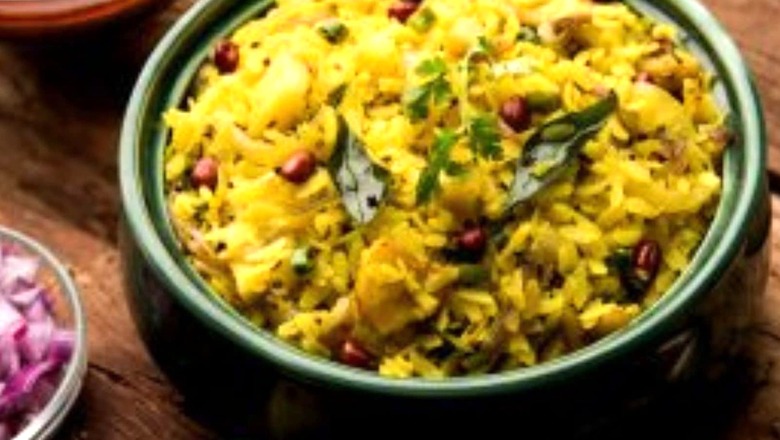
views
If you want to know what food means to people, and what great lengths a man will go to in search of a snack, you should step out on a Saturday night and try to jostle your way into the narrow lane of Indore’s Sarafa bazaar. It is war. Men, women and children are shoving, thrusting, and bulldozing their way to get their hands on Dahi Bade, Tikki Chole, Bhutte Ka Kees and Garadu. But before I go into greater details about the assortment and mish-mash of delicacies available in these 100-year-old arteries of this ancient city, let me tell you about Indore itself.
Indore in Madhya Pradesh was a trading hub between the Deccan and Delhi in the 16th century and was later built by Ahilyabai Holkar as their Maratha seat of power. Indore also being the commercial capital of Malwa region, the food here draws influence from Marwadi, Rajasthani cuisines and of course Maharashtrian food, which allows the food here to bait favour from the best of both worlds.
The one dish that is typically Maharashtrian but has been elaborated by the Indoris, with spice, embellishment and audaciousness, is the simple Poha. Usually made of flattened rice fried with onion, green chillies, spiced with turmeric and, garnished with coriander leaves, it is Indore’s favourite breakfast. At 6 in the morning, young and old alike dress up and meet at Head Sahab Ke Pohe at Old Palasia to eat Usal Pohe. This poha is served with a hot spicy chana usal, garnished with chopped onion, doused in a red-flaming hot oily soup called “tari” and then sprinkled with thin crispy sev, spicy gathia, loaded with sweetened dahi, and finished with chopped coriander. The poha has every conceivable taste and texture. Hot, spicy, sweet, crunchy, squishy, and other local words which challenges the English vocabulary. The Pohe are often eaten with piping hot jalebi. The Poha was introduced in Indore by a Maharashtrian family at Prashant Nasta Corner in 1949. They’re famous for their Indore Marathi style Aloo Poha. The shop opens early in the morning for breakfast, and stays crowded till it closes in the evening.
ALSO READ | What The Fork: Misal Pav to Egg Roast, Kunal Vijayakar on Mouth-watering Roadside Breakfast
But as night falls in the streets behind the crumbling Holkar Rajwada, and the jewellery shops on the Old Sarafa Bazaar down their shutters, the bazaar transforms and comes alive as a haven for street food and drama. Hawkers each with their own specialty to sell, perform, sing, dance, even spout poetry as they broadcast their delicacies.
Joshi Dahi Bada House is always crowded, not only are the customers waiting to get their share of ‘kachori’, ‘bhalle’, ‘mirchi vada’ and other ‘chaat’, they are enthralled by Joshi’s Flying Dahi Bada. Called so, because of his unique way of tossing the Dahi Bada high in the air as he deftly seasons it with five spices in one fist. Cold, sweet dahi over a soft fluffy ‘bhalla’. With sweet and chutneys, and powdered spices. Just heaven.
A-1 Garadu. This place is famous for ‘Bhutte Ka Kees’ and ‘Garadu’. ‘Bhutte Ka Kees’ is typical of the Marwari and Maharashtrian communities and is made of freshly ground corn cooked in ‘heeng’, turmeric and other spices and garnished with grated coconut chopped coriander leaves, and lemon juice. The septuagenarian owner of the stall, BC Agarwal, regales you with his take on the English language and entertains while he serves up the ‘Bhutte Ka Kees’ and while he fries the ‘Garadu’. ‘Garadu’ is small pieces of Yam, twice fried till they become crisp, then dusted with Chaat Masala. Crunchy gold brown winter treats.
ALSO READ | What The Fork: How Kunal Vijayakar Lost 15 Kilos without Missing out on Samosa or Tikka
Then there is Sawariya Chaat House. Their ‘Aloo Tikki Chole’ are legendary. The ‘aloo tikkis’, made with boiled potato are deep fried in ghee and crushed along the way, till each part of the now flattened ‘tikki’ becomes golden brown and crispy. Then the ‘tikki’ is covered with hot ‘chholay’ and a sweet ‘khajoor’ chutney and a spicy green chutney. It’s the crispiness and the size of the ‘tikki’ that makes it stand apart as one of a kind. Of course, in the usual Sarafa Bazaar drama style, he will feed you the first bit by his own hands.
There is much more in Sarafa Bazaar. ‘Doodh chana and namkeen’, ‘kabuli chana’, soaked in milk for several hours then fried and spiced, Kaanji Vada, bloated ‘vadas’ soaked in ‘kanji’, ‘Indori shikanji’, ‘Nagori ki Shikanji’, Indore’s ‘shikanji’ is not a limbu sherbet, but is made of milk and dry fruits and a dash of buttermilk.
There are Kachoris galore, Sabudana Khichi topped with the inevitable Indore Sev, Mithai, Rabdi, Malpua, Gulab Jamuns, milkshakes and juices. Navin Coconut Crush, where the man behind the counter hacks a coconut dramatically while his blender whirrs mixing coconut water and kernel to make the most refreshing nectar. A bejeweled Kulfi Falooda maker, Natwar Neema, who wears more kilos of gold than he sells kulfi. And finally there is the Jaleba. A gargantuan sized jalebi. Soft, crunchy hot and juicy, and impossible to resist especially when served with thick rabdi. The food is so good; it almost seems immoral.
Kunal Vijayakar is a food writer based in Mumbai. He tweets @kunalvijayakar and can be followed on Instagram @kunalvijayakar. His YouTube channel is called Khaane Mein Kya Hai. The views expressed in this article are those of the author and do not represent the stand of this publication.
Read all the Latest News , Breaking News and IPL 2022 Live Updates here.



















Comments
0 comment